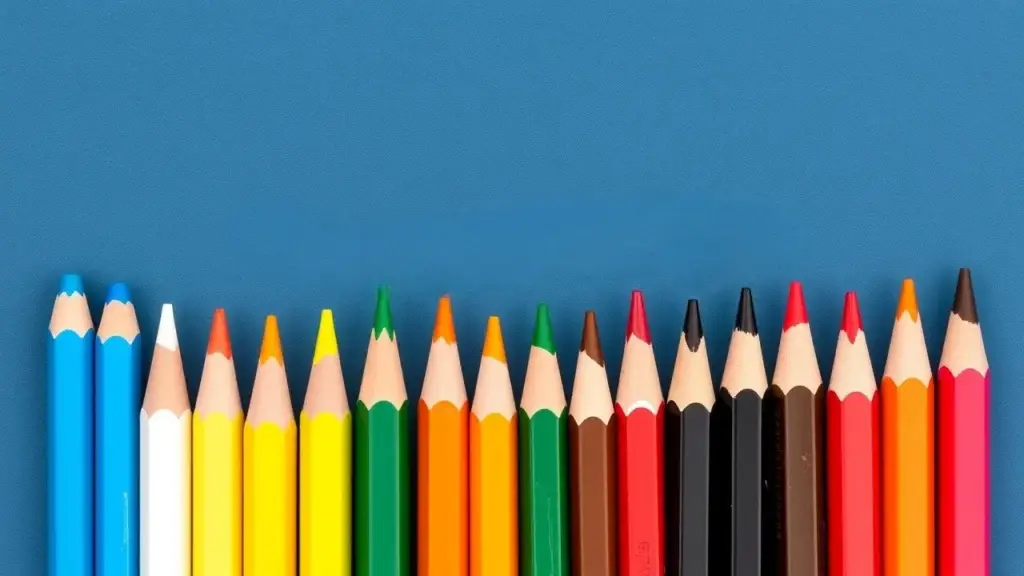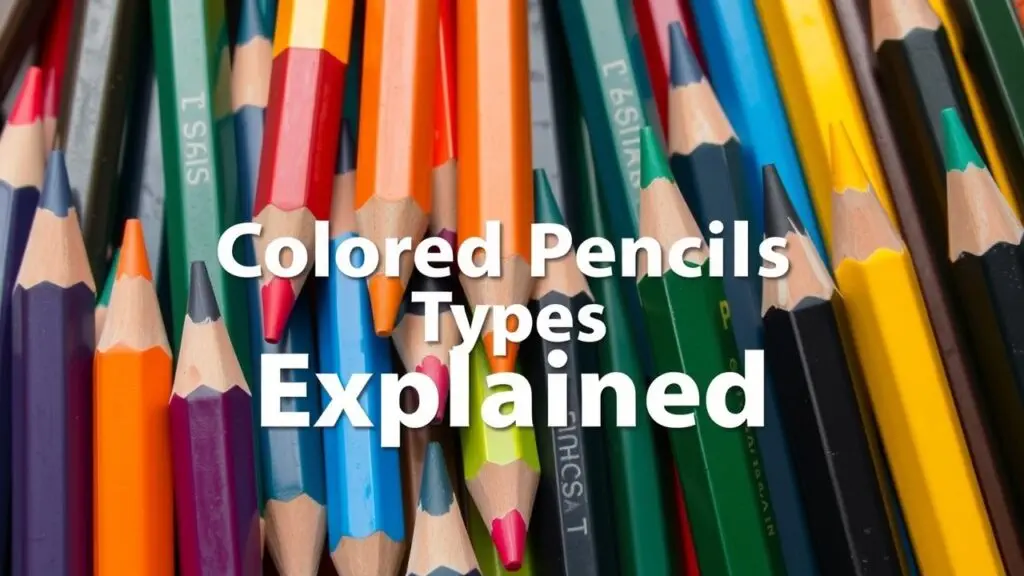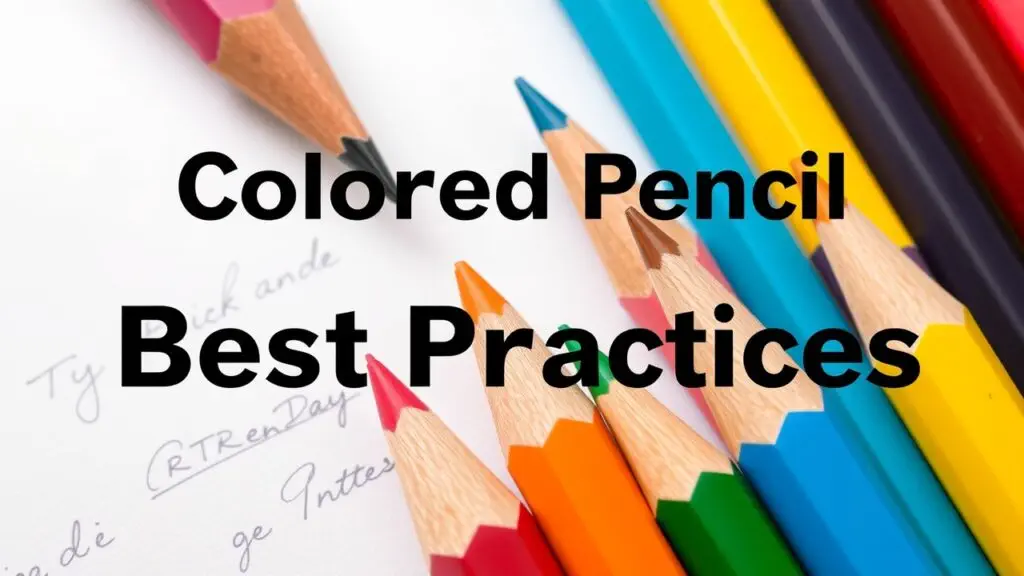This guide explores various types of colored pencils (wax, oil, water-soluble), comparing their properties and uses to help you choose the best pencils for your art projects.
What Are Colored Pencils?

Colored pencils are special tools used for art. They have a core made from pigment and a binder, which keeps everything together. The pigment gives the pencil its color, while the binder helps it go on paper smoothly. There are different kinds of colored pencils like wax-based colored pencils, oil-based colored pencils, and water-soluble colored pencils.
These tools are really versatile! Artists use them for many things. You can draw detailed pictures or color in intricate designs in adult coloring books. They’re also easy to carry around, so you can take them wherever you go.
Why Understanding Different Types Matters?
It’s good to know about the different types of colored pencils, especially if you want to make great art. Each type works differently when blending colors and layering techniques. For instance:
- Wax-based colored pencils have bright colors but might smudge.
- Oil-based colored pencils glide on smoothly and don’t smudge as much.
- Water-soluble colored pencils can turn into watercolor when you add water.
For beginners, choosing the right kind helps make learning easier. Pros might pick specific types for the results they want in blending or layering.
Overview of Main Categories
Here’s a quick look at the main types of colored pencils:
| Type | Characteristics | Uses |
|---|---|---|
| Wax-Based | Bright colors; smooth application; may smudge | Drawing; coloring books |
| Oil-Based | Smooth texture; less smudging; harder finish | Detailed artwork; professional projects |
| Water-Soluble | Turns into watercolor with water | Mixed media art; washes |
| Pastel Pencils | Soft and chalky feel | Blending soft edges in drawings |
Knowing these categories helps artists pick the right tools for their projects. This makes creating art more enjoyable and rewarding!
Types of Colored Pencils Explained
Wax-Based Colored Pencils
Wax-based colored pencils are a favorite for many artists and kids. They have soft cores that make it easy to apply color. These pencils give off bright colors that mix well. This is great for projects like coloring books. However, they can get a wax bloom. That’s a cloudy film that sometimes shows up after you color.
Advantages
One big plus of these pencils is they are cheap. They work well for beginners or casual artists because you can get bright colors easily.
Disadvantages
But there are some downsides too. The softer leads can break more often than harder ones. Also, they don’t layer as nicely as oil-based colored pencils.
Best Uses
You will find wax-based colored pencils best for coloring books and quick sketches where you want bold colors.
Oil-Based Colored Pencils
Oil-based colored pencils have a harder core that gives them strong pigment. These pencils are great for layering without worrying about wax bloom ruining your art.
Advantages
They last longer because they resist breaking. The colors are richer, which makes them ideal for detailed work like portraits and landscapes.
Disadvantages
But they cost more than wax-based ones, so be ready to spend a bit extra. Also, the learning curve can be steeper, which might scare off new users.
Best Uses
These pencils shine in professional settings where detail is crucial.
Water-Soluble/Watercolor Colored Pencils
Water-soluble or watercolor colored pencils let you create effects like watercolors when you add water. You can use them dry too, which gives you control over your lines.
These colors mix easily with water, but it’s important to pick the right paper so it doesn’t buckle or tear when wet.
Best Uses
They work well for blending backgrounds or making soft washes in mixed media projects where sketching meets painting.
Specialty Colored Pencils
Specialty colored pencils come in many types. Each type helps create different effects in art. They are perfect for adding cool touches to your drawings and crafts.
Metallic Colored Pencils
Metallic colored pencils have a shiny look. They shimmer and reflect light, which makes them fun to use. You can add highlights and cool effects with these pencils.
Best Uses
- Great for projects that need eye-catching details.
- Perfect for illustrations that want some sparkle, like cards or decorations.
Neon Colored Pencils
Neon colored pencils are super bright! They stand out on paper because of their intense colors. These vibrant shades help make bold statements in art.
Best Uses
- Perfect for adding bright accents to designs.
- Useful for creating strong contrasts in posters and graphic designs. Neon colors bring energy to any artwork!
Other Specialty Pencils
Pastel Pencils
Pastel pencils mix soft pastels with pencil convenience. They provide rich color while allowing detailed work like regular drawing tools.
Best Uses:
- Great for artists who like softer textures and blending.
- Ideal for portraits or landscapes where subtle colors matter.
Woodless Colored Pencils
Woodless colored pencils have no wood casing. This design allows you to sharpen them all the way down to a fine point without wasting material.
Best Uses:
- Good for making fine lines or shading.
- These pencils give you control over your art thanks to their solid structure, which lasts longer.
Colored Pencil Comparison

When picking colored pencils, it’s good to know the types you can choose from. This chart will help you understand key features and find the right ones for your art.
Key Features to Compare
| Feature | Wax-Based Pencils | Oil-Based Pencils | Water-Soluble Pencils |
|---|---|---|---|
| Binder Types | Made with wax; softer for blending. They are great for bright colors but may smudge. | Made with oil; firmer and better for details. They work well for layering without losing color. | These can be used wet or dry, making them fun for watercolor effects! |
| Pigment Levels | High pigment means bright colors, but not all brands are equal. | Rich pigments give deep colors, perfect for professionals. | Varies by brand; can look good when wet but may not be as rich as oil-based. |
| Blending Capabilities | Easy to blend because they are soft; perfect for smooth color transitions. | Good for blending too, especially with layers; needs more pressure. | Blends well both ways, allowing washes or cool gradients. |
Layering Techniques
Layering helps create depth in colored pencil art:
- Wax-Based Pencils: You can layer many times without damaging what’s underneath.
- Oil-Based Pencils: These hold their color well even after many layers.
- Water-Soluble Pencils: They layer good dry, but can be see-through when water is added.
Price Range Overview
Colored pencil prices differ based on type and brand:
- Student-grade Options: Usually cheap (about $10-$30), great for beginners.
- Artist-grade Options: Cost more (from $30 up to $100+) but offer better color and durability.
Knowing these features helps you choose the best colored pencils that fit your style.
This comparison shows key aspects of different colored pencils so artists of any skill level can pick what works best while considering their budget!
Choosing the Right Colored Pencils
Skill Level Considerations
Picking the right colored pencils is a big deal, and your skill level matters a lot. Here’s a simple breakdown:
- Beginner Colored Pencils: These are great for newbies. They usually cost less and have softer leads. This makes them easier to use.
- Artist-Grade Colored Pencils: If you’ve got some experience, you might want professional or artist-grade pencils. They have better colors and blending abilities. Popular brands include Prismacolor Premier and Faber-Castell Polychromos.
Finding the best colored pencils really depends on how skilled you are. Beginners might want to stick to student-grade options for ease of use, while pros will want the best materials for amazing results.
Project Requirements
What you plan to create can change which colored pencils you should choose. Different art styles need different tools:
- Color Blending Techniques: If blending colors is your goal, look for wax-based or oil-based pencils. They mix together nicely.
- Layering Techniques: For layering colors well, high-quality oil-based or wax-based pencils work best because they let you add more layers without losing brightness.
Knowing what techniques you want to use helps in picking the right pencil type for your projects.
Techniques and Effects
Colored pencils can produce various artistic effects:
- Shading Techniques: Oil-based pencils are smooth and perfect for shading since they glide easily on paper.
- Color Mixing: Water-soluble colored pencils are awesome for creating washes when mixed with water. They are perfect for mixed media art!
When you know which pencil works best for each technique, your artwork will look even better.
Budget Considerations
Money is always a thing when it comes to choosing tools:
Prices of colored pencils can vary a lot:
- Affordable choices: Many beginner sets are available under $50.
- Mid-range sets: Good quality student-grade sets often range from $50 to $100.
- Premium brands: High-end artist-grade sets can go over $100 but perform really well.
By checking out price ranges of brands like Prismacolor Premier and Faber-Castell Polychromos, you can find what fits your budget without sacrificing quality.
To wrap it up, picking the right colored pencil involves looking at your skill level, project needs, budget limits, and the techniques you plan to use. Whether you’re just starting out or you’re a seasoned artist, considering these factors will help you choose the right tools to make your coloring shine!
Best Practices for Using Colored Pencils

Sharpening Techniques
To get the best out of your colored pencils, you need to sharpen them right. Sharpening helps you make fine lines and details in your art. You can choose between manual pencil sharpeners and electric ones. Manual sharpeners let you control how sharp you want the pencil, while electric ones are faster but can take off more wood than needed.
When sharpening colored pencils, just put the pencil in and twist it gently. Stop when it looks good; too much sharpening might break the lead inside. If you’re looking for a super sharp point, try using a knife to shape it just the way you like.
Layering Strategies
Layering colors is a great way to add depth to your drawings. It helps create rich colors that stand out. Start with light layers and slowly build up the color. This way, you won’t overwhelm your paper.
Try different pressures when applying each layer. Light pressure gives softer colors, while heavy pressure makes darker shades pop. The best colored pencils for layering are those with a lot of pigment. They mix well without turning muddy or dull.
Blending Techniques
Blending makes your artwork look smooth and professional. You can use tools like blending stumps or tortillons for this purpose. These tools help merge colors nicely together.
Another method is burnishing, which means pressing hard with a lighter color over darker layers to shine them up. You can also use solvents like rubbing alcohol or mineral spirits to help blend the colors together better, giving you that smooth finish.
Paper Selection
Picking the right paper for colored pencils is very important. Look for drawing paper that works well with colored pencils so your colors shine bright. Acid-free paper is best because it keeps your art from turning yellow over time.
You can also try mixed media paper if you plan to use watercolors along with your colored pencils. It holds up well and gives you lots of options for creativity.
Proper Storage
Taking care of your colored pencils helps them last longer! Good storage means they won’t break easily or get damaged. Use storage solutions like cases or trays that keep everything organized by color or type.
This way, your art supplies stay safe and ready for whenever inspiration strikes!
FAQs About Types of Colored Pencils
What are the best colored pencils for students?
The best colored pencils for students include Prismacolor Scholar and Crayola Colored Pencils. They provide good quality at an affordable price. Both brands offer vibrant colors, making them ideal for school projects.
What is the difference between student-grade and professional colored pencils?
Student-grade colored pencils are cheaper and easier to use. They have softer leads. Professional colored pencils offer better pigments and durability. These are suitable for serious artists.
Which colored pencils are best for blending?
For blending, try Prismacolor Premier or Faber-Castell Polychromos. Both brands excel in color mixing due to their high pigment content. They allow smooth transitions between shades.
What are metallic and neon colored pencils?
Metallic colored pencils add shimmer to artwork. Neon colored pencils offer bright, vibrant colors. Both types enhance your art with special effects and are fun to use.
How do I store my colored pencils?
Store colored pencils in cases or trays to keep them organized. This prevents breakage and helps you find colors quickly. Keep them away from heat and moisture for best results.
Can you use water-soluble pencils like regular colored pencils?
Yes, water-soluble pencils can be used dry like regular ones. You can also blend them with water for a watercolor effect. This versatility makes them great for mixed media projects.
What brands make high-quality oil-based colored pencils?
Caran d’Ache and Lyra Polycolor offer excellent oil-based options. Their pencils have rich pigmentation and durability, making them perfect for detailed work.
Additional Keywords to Explore
- Colored Pencil Techniques: Explore blending techniques for smooth transitions.
- Pencil Sharpness: Understand sharpening methods that suit your art style.
- Durability of Pencils: Learn how different types last through usage.
- Affordable Colored Pencils: Find budget-friendly options without sacrificing quality.
- Best Colored Pencils for Detail Work: Choose specific brands known for precision.
- Colored Pencil Projects: Try new ideas using various types of colored pencils.
- Colored Pencil Care Tips: Maintain your supplies for longer-lasting use.
- Pencil Hardness Levels: Discover how hardness affects application and texture.
- Erasability of Colored Pencils: Check which types erase cleanly without damage.
- Colored Pencil Blending Tools: Use tools like stumps or tortillons for better results.
Related Topics
- types of pencil sharpening techniques
- types of colored pencil blending techniques
- types of colored pencil layering strategies
- types of colored pencil paper
- types of colored pencil storage solutions
- types of colored pencil brands
- types of colored pencil projects
- types of colored pencil art techniques
- types of colored pencil shading techniques
- types of colored pencil effects
- types of art supplies for colored pencils



Types of Colored Pencils: A Complete Guide